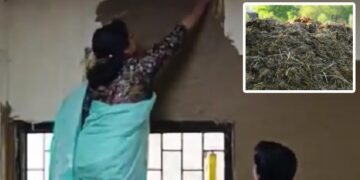In an unexpected move that has sparked widespread controversy, Dr. Pratyusha Vatsala, the Principal of Laxmibai College at Delhi University, has come under fire for applying cow dung to the walls of classrooms in an attempt to reduce the heat during the scorching summer months. The experiment, which was intended to revive an age-old traditional practice, has raised questions about its scientific validity and the appropriateness of using such methods in an educational setting.
The initiative was introduced by Dr. Vatsala as a way to tackle the rising temperatures in the college, which many students had complained were making classrooms unbearable. According to the principal, the use of cow dung, a practice rooted in traditional Indian practices, was thought to have insulating properties that could reduce the heat inside the rooms. The principal argued that cow dung has been historically applied to walls to keep temperatures low and provide a natural, eco-friendly solution to combating heat.

“We are simply bringing back a method that has been used in rural India for centuries,” Dr. Vatsala stated in her defense. Principal “This is an experiment to see if this natural method can help with temperature control and maintain a healthier environment for our students.”
While the principal’s intentions may have been rooted in tradition, the reaction from students has been overwhelmingly negative. Many students took to social media to voice their frustration, questioning the appropriateness of the experiment and the scientific basis behind it.
“I can’t believe we are in a modern university and our principal is applying cow dung to the walls. It’s not only ineffective, but it’s also unhygienic,” said Ayesha, a student from the second year. “This is not the kind of initiative we expect from an institution of higher learning. We want solutions based on science, not on outdated practices.”
Several students have expressed concerns over the health risks associated with using cow dung in classrooms, particularly its potential to attract pests or create an unhygienic environment. They have also questioned whether proper research had been conducted before implementing such an unorthodox method.Principal
The debate surrounding the use of cow dung highlights a deeper issue: the tension between traditional methods and modern scientific approaches. In India, cow dung has been used in rural areas for centuries in various ways, from as a building material to a cleaning agent. However, its application in an academic setting, especially one in an urban and highly modernized institution like Delhi University, is seen by some as an attempt to turn back the clock.Principal

Environmentalists, however, have noted that cow dung is a biodegradable material and, in certain rural contexts, it can have sustainable benefits. “In villages, cow dung is used because it’s cheap, natural, and sustainable. But in a college with access to modern cooling technologies, such measures don’t seem appropriate or effective,” explained Dr. Arvind Kumar, an environmental scientist.
In the face of mounting criticism, the college administration has defended Dr. Vatsala’s decision, asserting that the experiment was conducted with the well-being of students in mind. A spokesperson for the college said, “The principal’s actions were meant to bring attention to the traditional practices that have been part of our cultural heritage. It was an experimental initiative and not intended to be a permanent solution.”
The administration further emphasized that they would be reviewing the feedback from students and faculty members to ensure that the environment within classrooms remains conducive to learning.
This incident has sparked a broader conversation about the role of traditional practices in modern education and whether they should be integrated into contemporary settings. While cultural heritage is undoubtedly important, the need for evidence-based solutions to problems like heat management in classrooms is equally crucial.
Experts argue that universities should focus on sustainable and scientifically backed methods, such as energy-efficient cooling systems, improved ventilation, and the use of eco-friendly materials that align with modern environmental standards. Some students have suggested that the administration invest in more conventional measures, like air conditioning or the use of plants, to naturally cool the environment.
In the wake of this controversy, Dr. Vatsala and the administration have been urged to take student concerns into account and consider more contemporary approaches to managing the heat in classrooms.
While the use of cow dung may have sparked debate, it has certainly opened the door to a larger discussion about the balance between tradition and innovation, and how educational institutions can find solutions that are both respectful of heritage and aligned with scientific progress.
As Laxmibai College moves forward with the academic year, this controversy serves as a reminder of the ongoing struggle to harmonize the old with the new. Whether this experiment will be remembered as a bold, albeit misguided, attempt to blend tradition with innovation, or as a cautionary tale about the importance of critical thinking in educational decision-making, remains to be seen.















 Categories
Categories










